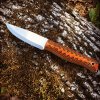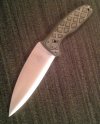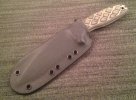A number of fine knives recommended.
1. I have a mechanics box of just Moras. Two weeks ago, I gave three Moras with modified sheaths to relatives.
The following has been my thinking.
a. I am urban. Way past the Rambo stage of life. Survival will require a group. Whether the knives are trading goods or supplied to people in my circle, I can train people in knife fighting.
b. Nearly all the sheaths were modified with survival requirements in mind.
c. Additional sheaths were purchased for horizontal, behind the back carry despite them costing more than a knife.
2. In Scandinavia, a very basic Mora type knife is given to a boy and he learns survival skills as he grows up. Most Americans in urbanized environments won't have those skills, so the grind of the blade, the steel, the material of the handle are completely meaningless. A manufacturer's warranty is equally useless after shtf. That is r e a l i t y!
3. You don't have to spend a lot of money for an outdoor knife. The three family members received Schrade fixed blades.
4. In a drawer in the living room is a Fallkniven F1 survival knife within a kydex sheath for horizontal carry.
5. In the office, it is an inexpensive Ka-bar version of the WW2 Navy Dive knife. My dad did salvage work for a while in WW2. For that matter, you could get a Cold Steel survival knife with a 6 inch blade or the Cold Streel Recon tanto. If you have access to a tin snips or ability to cut rubber, Get the current version of the Ontario 499 survival knife and cut off the rubberized top guard and you are good to go for way under $50.
1. I have a mechanics box of just Moras. Two weeks ago, I gave three Moras with modified sheaths to relatives.
The following has been my thinking.
a. I am urban. Way past the Rambo stage of life. Survival will require a group. Whether the knives are trading goods or supplied to people in my circle, I can train people in knife fighting.
b. Nearly all the sheaths were modified with survival requirements in mind.
c. Additional sheaths were purchased for horizontal, behind the back carry despite them costing more than a knife.
2. In Scandinavia, a very basic Mora type knife is given to a boy and he learns survival skills as he grows up. Most Americans in urbanized environments won't have those skills, so the grind of the blade, the steel, the material of the handle are completely meaningless. A manufacturer's warranty is equally useless after shtf. That is r e a l i t y!
3. You don't have to spend a lot of money for an outdoor knife. The three family members received Schrade fixed blades.
4. In a drawer in the living room is a Fallkniven F1 survival knife within a kydex sheath for horizontal carry.
5. In the office, it is an inexpensive Ka-bar version of the WW2 Navy Dive knife. My dad did salvage work for a while in WW2. For that matter, you could get a Cold Steel survival knife with a 6 inch blade or the Cold Streel Recon tanto. If you have access to a tin snips or ability to cut rubber, Get the current version of the Ontario 499 survival knife and cut off the rubberized top guard and you are good to go for way under $50.




